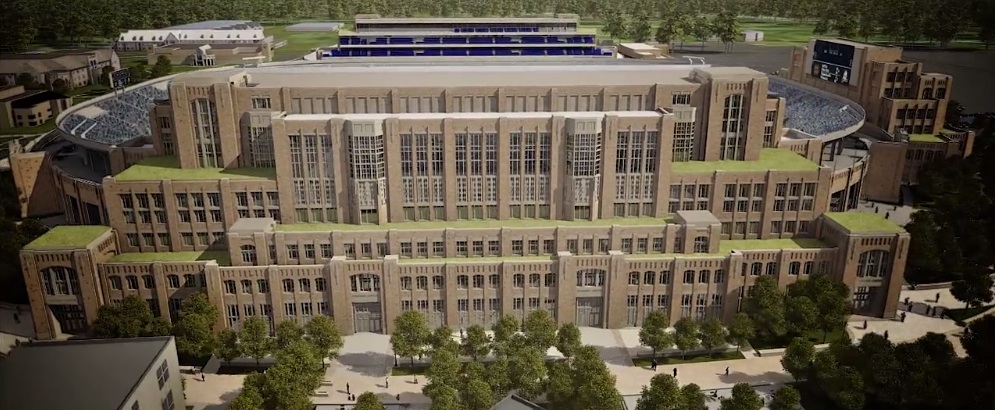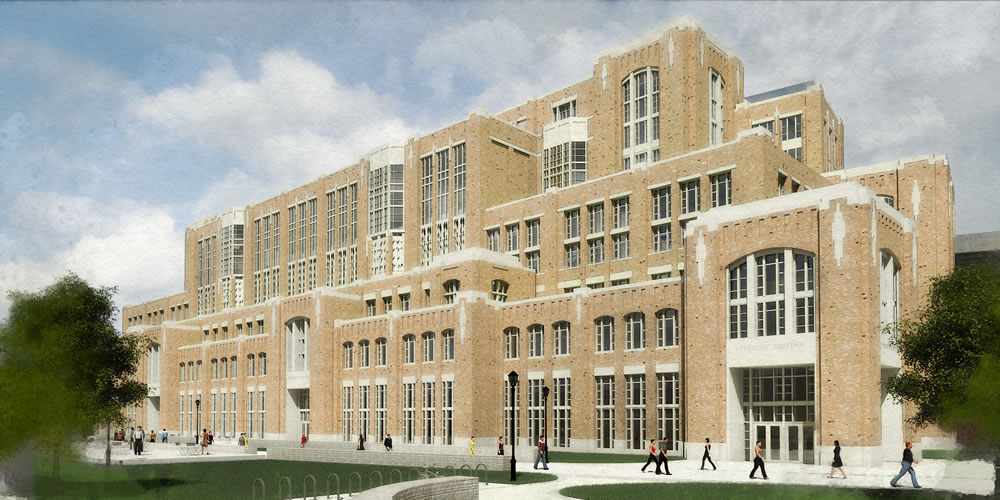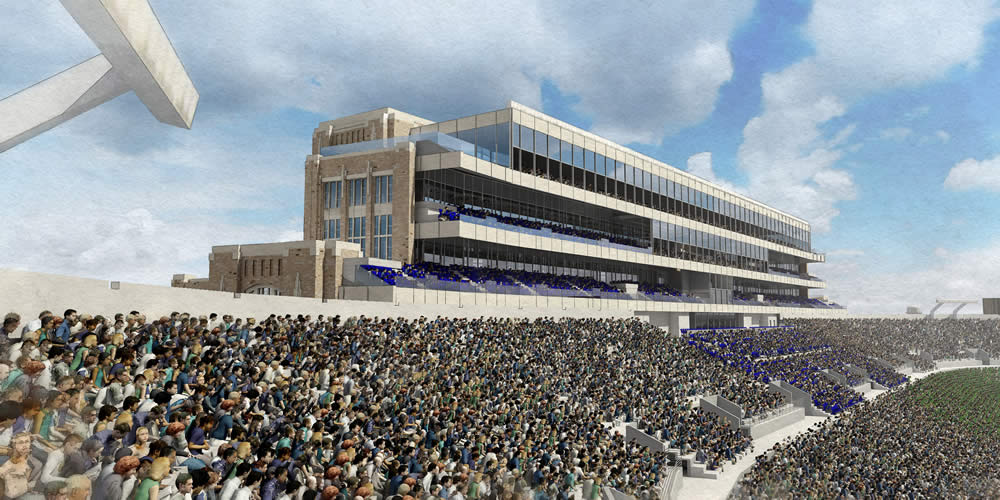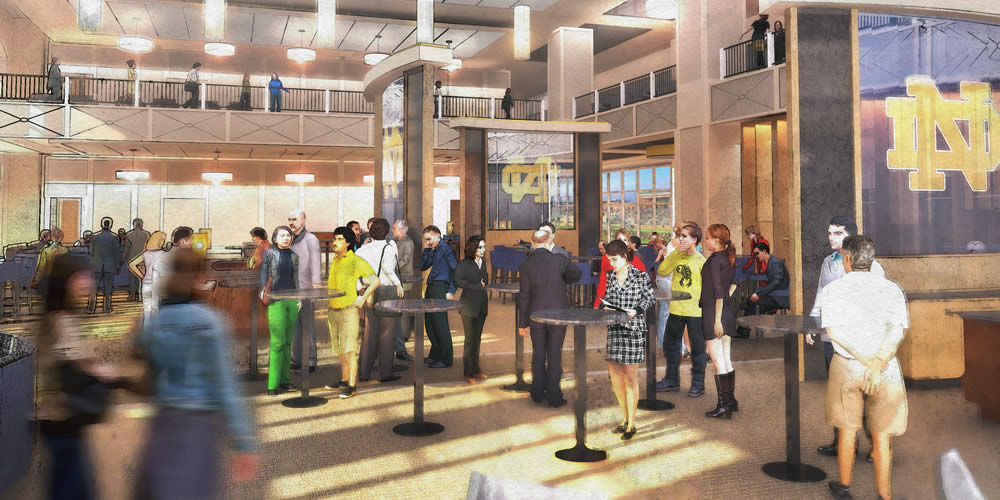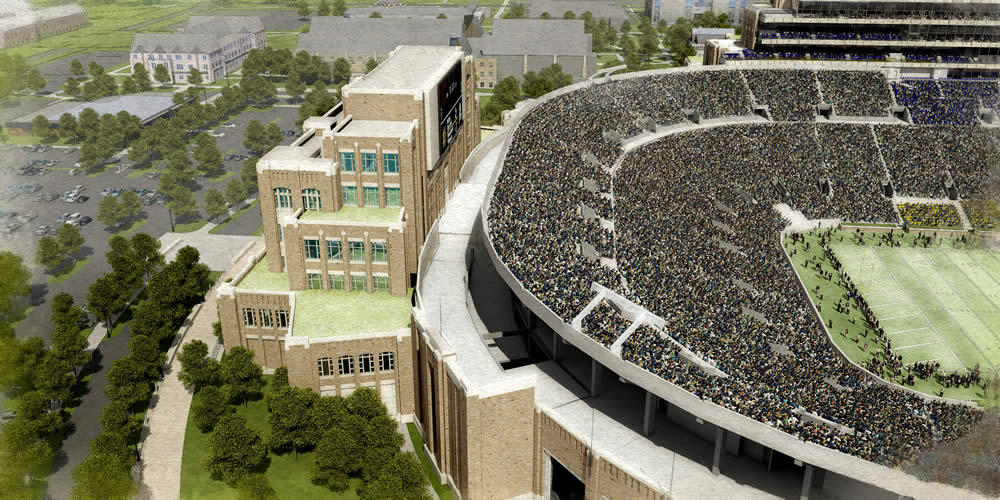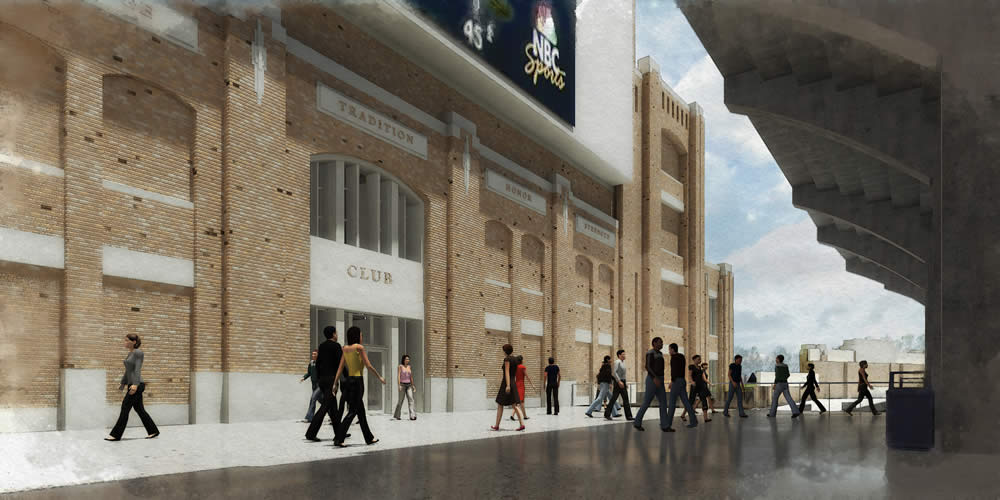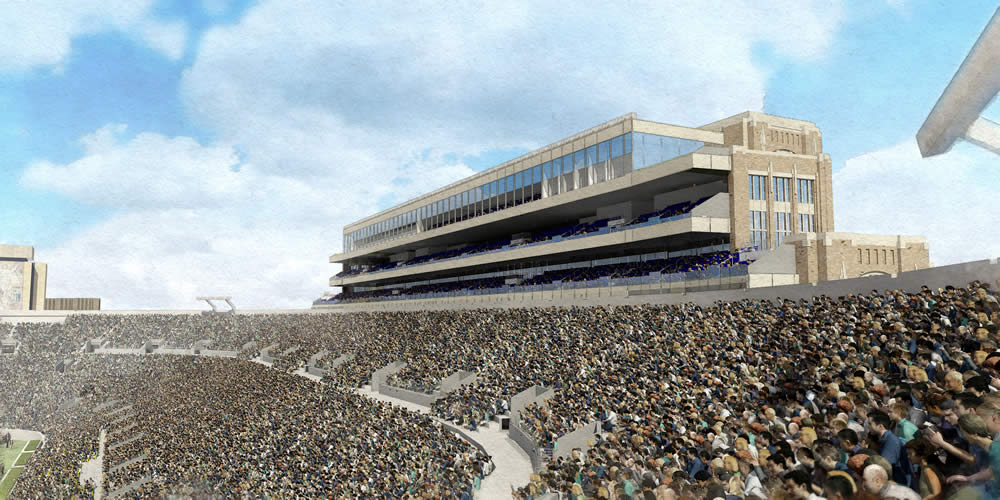The University of Notre Dame announced this morning the largest building project in its 172-year history, integrating the academy, student life, and athletics with the construction of more than 750,000 sf in three new buildings attached to the west, east, and south sides of the school's iconic football stadium, at a projected cost of $400 million.
The plan, called the Campus Crossroads Project, features new structures attached to and serving the stadium: a west building for student life services, including space for student organizations, a recreation center and career center; an east building for the anthropology and psychology departments and a digital media center; and a south building for the Department of Music and the Sacred Music at Notre Dame program. The east and west buildings also will include some 3,000 to 4,000 premium seats for the football stadium with supporting club amenities.
The lead architectural firm for the Crossroads Project is The S/L/A/M Collaborative. RATIO Architects is the co-designer. Other consultants include Workshop Architects for the student center and 360 Architecture for the recreation, fitness, and hospitality areas. The contractor is Barton Malow Co.
Central components to the plan include the addition of meeting, research, and teaching venues, as well as facilities that do not currently exist on campus, such as a 500-person ballroom. The various new spaces also will be designed to accommodate multiple functions for multiple departments, such as the stadium club spaces, which also will be used for student services, academic event space, classrooms, conferences, career fairs, and other campus and community activities.
The exterior design of the Campus Crossroads Project is inspired by Knute Rockne’s original Notre Dame Stadium—which still stands today as the core of the facility—and is wed with materials, massing, and details taken from many of the Collegiate Gothic buildings on the campus.
The area between the stadium and the DeBartolo Hall classroom building will become a pedestrian plaza with walkways, trees, planters, and seating areas. The entire project will include sustainability practices consistent with other University projects.
The project also will enhance the football fan experience on game days. A variety of premium seating options—both indoor and outdoor and mostly club seats—will be available on three upper levels on the east and west sides. A hospitality area also is planned for the new building on the south end of the stadium.
Football fans, especially younger ones, have expressed a clear desire to have better access to data and video when attending Notre Dame games. Some of that will be addressed through enhanced broadband connectivity and some by the introduction of video, though the shape that will take has not yet been finalized. However, to the extent the University provides video, whether in the concourse or in the stadium itself—similar to the philosophy in Purcell Pavilion and the Compton Family Ice Arena—there will be no commercial signage or advertising.
Notre Dame Stadium opened in 1930 and was expanded to its current configuration in 1997. One of the nation’s most iconic athletics venues, it is used for home football games, the University Commencement Ceremony and several other events.
Features of the three new buildings include:
West building
Space designed to enhance student development and formation will dominate the nine-story west building. Planning has ensured that the new facility will complement the student organization space and administrative offices located in the historic LaFortune Student Center.
Levels 1 and 2: Flexible, state-of-the-art meeting rooms, graduate and undergraduate student lounges, a dining area, student organization space and administrative offices.
Levels 3 and 4: Recreational sports and fitness facilities (the Rolfs Sports Recreation Center will become the practice home for the men’s and women’s varsity basketball teams).
Level 5: A career services center, centralized and expanded with more than 40 interview rooms, multiple training rooms and conference areas, an employer lounge and advising offices. The existing working press space on this level will be integrated into a premium seating area for the stadium.
Level 6: Mechanical support.
Level 7: A 500-seat student ballroom, club seating for football and booths for NBCSports telecasts of home football games. Student-oriented programming will have priority booking for non-game weekends.
Level 8: Premium stadium seats and terraces that will look onto the campus and the playing field.
Level 9: Club seating, boxes for home and visiting coaches, security booths and boxes for administrative and athletic department leaders.
Basement: Food service space for the three new buildings and the stadium.
South building
The relocation of the Department of Music and Sacred Music Program will provide much needed new and state-of-the-art space for these growing programs. It also will put music into close proximity to other performing arts departments and programs.
Level 1: Recital and rehearsal halls and the Leahy gate grand entrance to the stadium.
Level 2: A large music library, to be relocated from the Hesburgh Library, classrooms and rehearsal and tutoring rooms.
Level 3: A 350-person club/lounge.
Level 4: Department of Music offices, practice rooms and storage.
Level 5: The Sacred Music Program, offices, organ practice rooms and storage.
Level 6: Mechanical, with a scoreboard on the exterior.
East building
Offices and laboratories for the Departments of Anthropology andPsychology, which are housed in a variety of buildings on campus, now will be in one place and located closer to other social sciences departments, the College of Scienceand international institutes.
Level 1: A digital media center with a 2,000-square-foot studio and production, teaching, learning, research and scholarship facilities for use by faculty, students, University Communications, athletics and information technology will position Notre Dame as a national leader in what is a rapidly expanding and increasingly important component of higher education. A control room will support faith-based programming, such as Masses at the Basilica of the Sacred Heart, as well as athletics events, performing arts presentations and academic lectures and speeches.
Level 2: Anthropology offices, administrative space, conference and tutoring areas and multifunction research and teaching labs.
Levels 3, 4 and 5: Psychology offices, classrooms, labs, computer rooms and a student lounge.
Level 6: Mechanical support.
Level 7: Outdoor club seating for football, outdoor terraces and a large space that will double as a club area and flexible classroom.
Level 8: Outdoor club seating for football.
Level 9: Working press box, radio booths and a club area with indoor and outdoor premium seating for football.
For more on the Campus Crossroads Project, visit: http://crossroads.nd.edu.
Related Stories
MFPRO+ New Projects | Mar 18, 2024
Luxury apartments in New York restore and renovate a century-old residential building
COOKFOX Architects has completed a luxury apartment building at 378 West End Avenue in New York City. The project restored and renovated the original residence built in 1915, while extending a new structure east on West 78th Street.
Multifamily Housing | Mar 18, 2024
YWCA building in Boston’s Back Bay converted into 210 affordable rental apartments
Renovation of YWCA at 140 Clarendon Street will serve 111 previously unhoused families and individuals.
Healthcare Facilities | Mar 17, 2024
5 criteria to optimize medical office design
Healthcare designers need to consider privacy, separate areas for practitioners, natural light, outdoor spaces, and thoughtful selection of materials for medical office buildings.
Construction Costs | Mar 15, 2024
Retail center construction costs for 2024
Data from Gordian shows the most recent costs per square foot for restaurants, social clubs, one-story department stores, retail stores and movie theaters in select cities.
Architects | Mar 15, 2024
4 ways to streamline your architectural practice
Vessel Architecture's Lindsay Straatmann highlights four habits that have helped her discover the key to mastering efficiency as an architect.
Healthcare Facilities | Mar 15, 2024
First comprehensive cancer hospital in Dubai to host specialized multidisciplinary care
Stantec was selected to lead the design team for the Hamdan Bin Rashid Cancer Hospital, Dubai’s first integrated, comprehensive cancer hospital. Named in honor of the late Sheikh Hamdan Bin Rashid Al Maktoum, the hospital is scheduled to open to patients in 2026.
Codes and Standards | Mar 15, 2024
Technical brief addresses the impact of construction-generated moisture on commercial roofing systems
A new technical brief from SPRI, the trade association representing the manufacturers of single-ply roofing systems and related component materials, addresses construction-generated moisture and its impact on commercial roofing systems.
Sports and Recreational Facilities | Mar 14, 2024
First-of-its-kind sports and rehabilitation clinic combines training gym and healing spa
Parker Performance Institute in Frisco, Texas, is billed as a first-of-its-kind sports and rehabilitation clinic where students, specialized clinicians, and chiropractic professionals apply neuroscience to physical rehabilitation.
Market Data | Mar 14, 2024
Download BD+C's March 2024 Market Intelligence Report
U.S. construction spending on buildings-related work rose 1.4% in January, but project teams continue to face headwinds related to inflation, interest rates, and supply chain issues, according to Building Design+Construction's March 2024 Market Intelligence Report (free PDF download).
Apartments | Mar 13, 2024
A landscaped canyon runs through this luxury apartment development in Denver
Set to open in April, One River North is a 16-story, 187-unit luxury apartment building with private, open-air terraces located in Denver’s RiNo arts district. Biophilic design plays a central role throughout the building, allowing residents to connect with nature and providing a distinctive living experience.



